Mafic and felsic magmatism in the Wadi Kalalat area,South Eastern Desert,Egypt:mineralogy,geochemistry and geodynamic evolution during the Neoproterozoic in the Nubian Shield
2024-03-06AdelSurourAhmedMadaniMohamedElSobky
Adel A.Surour • Ahmed A.Madani • Mohamed A.El-Sobky
Abstract In the south Eastern Desert of Egypt,two contrasting types of magmatism(mafic and felsic)are recorded in the Wadi Kalalat area,and form the Gabal El Motaghiarat and Gabal Batuga intrusions,respectively.The two intrusions post-dates ophiolitic and arc associations represented by serpentinite and metagabbro-diorite,respectively.The mafic intrusion has a basal ultramafic member represented by fresh peridotite,which is followed upward by olivine gabbro and anorthositic or leucogabbro.This mafic intrusion pertains to the Alaskan-type mafic–ultramafic intrusions in the Arabian–Nubian Shield (ANS)being of tholeiitic nature and emplaced in a typical arc setting.On the other hand,the Gabal Batuga intrusion comprises three varieties of fresh A-type granites of high K-calc alkaline nature,which is peraluminous and garnetbearing in parts.A narrow thermal aureole in the olivine gabbro of the mafic intrusion was developed due to the intrusion of the Batuga granites.This results in the development of a hornfelsic melagabbro variety in which the composition changed from tholeiitic to a calc-alkaline composition due to the addition of SiO2,Al2O3,alkalis,lithosphile elements (LILEs) such as Rb (70 ppm) and Y(28 ppm) from the felsic intrusion.Outside the thermal aureole,Rb amounts 2–8 ppm and Y lies in the range<2–6 ppm.It is believed that the Gabal Batuga felsic intrusion started to emplace during the waning stage of an arc system,with transition from the pre-collisional (i.e.,arc setting) to post-collisional and within plate settings.Magma from which the Gabal Batuga granites were fractionated is high-K calc-alkaline giving rise to a typical post-collisional A-type granite (A2-subtype) indicating an origin from an underplating crustal source.Accordingly,it is stressed here that the younger granites in the ANS are not exclusively post-collisional and within-plate but most likely they started to develop before closure of the arc system.The possible source(s) of mafic magmas that resulted in the formation of the two intrusions are discussed.Mineralogical and geochemical data of the post-intrusion dykes(mafic and felsic) suggest typical active continental rift/within-plate settings.
Keywords Wadi Kalalat ∙Gabal El Motaghairat mafic intrusion ∙Gabal Batuga felsic intrusion ∙Arc setting ∙Post-collision ∙Within-plate
1 Introduction
The post-ophiolite epoch in the Eastern Desert of Egypt,representing part of the western segment of the Arabian–Nubian Shield (ANS),is characterized by islandarc(s)mafic magmatism with an average 881 ± 58 Ma age(Abdel-Rahman 1990).This magmatism produced complex arc-related intrusions of gabbro-diorite-tonalite that formed mostly by fractional crystallization (e.g.,Abu El-Ela 1997;Ali et al.2005;Abdel-Karim et al.2021).Relatively older metagabbros partially formed part of the ophiolites and crystallized from mantle-derived magma,with some crustal fusion,which sourced from recycling of ancient oceanic mafic slabs(e.g.,Abu El-Ela 1997;Abdel-Karim et al.2008,2014;Maurice et al.2013).In addition,some authors proposed that they are Alaskan-type mafic intrusions in the Egyptian Eastern Desert that formed at the arc stage with no metamorphism (e.g.,Helmy et al.2008;Abdel Halim et al.2016).The Cryogenian island-arc and Alaskan-type gabbros in Egypt differ geochemically from the post-collisional younger gabbros that formed in a typical within-plate setting during the late Ediacaran (e.g.,Azer et al.2022).The former have typical arc compositions that are depleted in high-field strength elements (HFSE)such as Zr,Nb and Ti (e.g.,Abu Anbar 2009;Abd El-Rahman et al.2012;Abdel-Karim 2012).
Abundance of granitic rocks in Egypt,as well as in the rest of the ANS,lies in the range 50–70%(Stern and Hedge 1985;Farahat et al.2007,2011;El-Bialy and Streck 2009;Johnson et al.2011).They comprise two distinct groups;namely the arc stage granitoids (I) followed by post collisional to within-plate younger granites (GII&III).The first group formed at 720–650 Ma in a compressional setting(e.g.,Greiling et al.1984;Stern and Hedge 1985;Abdel-Karim and Arva-Sos 2000;El-Bialy and Streck 2009)whereas the second group formed at ≤650–590 Ma,but magmatism possibly continued into the Cambrian (~520 Ma) in a transpressional setting (e.g.,Hassan and Hashad 1990;Moussa et al.2008;Farahat et al.2011;Fritz et al.2013;El-Bialy and Omar 2015).El Bahariya (2021)stressed the parameters that resulted in different tectonic settings for magma generation and emplacement;namely transition from the calc-alkaline compressional magmatism to extensional alkaline to peralkaline within-plate representing older and younger granites,respectively.According to a recent review on the Egyptian granitic rocks,Abd El-Naby (2021) proposed the generation of calc-alkaline magma(s) from either melting of crustal rocks or by fractionation from mantle-derived,LILE-enriched basaltic melts in subduction settings.By contrast,the younger granites are 635–590 Ma highly fractionated calc-alkaline(mostly metaluminous I-type and alkaline 608–580 Ma(mostly peraluminous to peralkaline) A-type Ma granites.
The Wadi Kalalat area in the south Eastern Desert represents a unique part of Neoproterozoic crust in the western segment of the Arabian–Nubian Shield (ANS)(Ghazaly et al.2016;Abdel Halim et al.2016;El Sobky et al.2020;Sadek et al.2020;El Sobky 2021).The uniqueness is attributed to the exposures of a wide variety of Neoproterozoic rocks that represent almost all stages of Late Cryogenian and Ediacaran magmatic and metamorphic evolution from opening of old ocean and the formation of ophiolites until the arc and collisional stages were terminated,followed by the final phase(s) of magmatism,which took place in a within-plate regime.Accordingly,the Wadi Kalalat area represents a target area for studying the major tectonic stages that constitute the major components of the ANS evolution (Johnson et al.2011).Prior to the identification of ophiolites in Egypt,Bassiony et al.(1970)maintained in the geology of the Wadi Kalalat area was dominated by a geosynclinal rock association represented by two types of serpentinites,in addition to an undifferentiated metagabbro-diorite complex and plutons of fresh gabbro and granite.The first documentation of an ophiolitic me´lange and the fingerprints of the Pan-African orogeny in the area was reported in Ali et al.(2005)who concentrated their work on the within-plate granites and related pegmatites especially those that are anomalously radioactive.Abdel Aziz and Hegazy(2007),Abdel Halim et al.(2016),Ghazaly et al.(2016) and El Sobky (2021) concentrated their research on the diverse magmatic rocks,which belong to both arc and post-arc tectonic regimes.
In this paper,the authors present the first detailed account on the magmatic history in terms of geological constraints (mineralogy,geochemistry and geodynamic evolution) in the Wadi Kalalat area.It is planned to distinguish the different types of fresh or non-metamorphosed intrusions that range in composition from mafic (Gabal El Motaghiarat) to felsic (Gabal Batuga) and assign each phase of magmatism to its tectonic regime.In addition,the authors try to present a comprehensive model of magma evolution at different stages of orogenic activity from the arc to within-plate settings passing through the post-collisional stage in the Arabian–Nubian Shield.Special attention is paid to the dykes that traverse the shield rocks in the area.
2 Methods
The field excursions to the Wadi Kalalat area concentrated on its eastern part,which is adjacent to the Miocene Red Sea coastal plain and the Quaternary to Recent wadi alluvium.The authors focused on the mafic and felsic plutons with special attention to the contact relationships with the country rocks either lithological or structural.Some recent Landsat-8 images merged with band 2 of the Sentinel-2 were helpful for the field work.Different varieties of gabbroic and granitic rocks have been sampled systematically in order to provide a collective overview of mineralogical and geochemical variations for the sake of petrogenesis.
The samples from the two intrusions were collected along E–W and N–S profiles taking in consideration variation in colour,grain size and freshness.Total number of samples from the felsic intrusion was forty-two whereas it was thirty-six from the mafic intrusion.Systematic sampling has been performed taking in consideration all rock varieties in the same pluton and to be representative for all parts;namely center,intermediate zone and margin.Thinsections as well as some representative polished-sections were prepared to identify minerals and their textural relationships both in transmitted and reflected light.Wholerock chemical analyses for major oxides and some important trace elements were carried out using the X-ray Fluorescence (XRF) technique.This facility was accessed at the central laboratories of the Egyptian Mineral Resources Authorities (EMRA) in Dokki,Egypt.This technique enables the detection and measurement of a wide range of elements from beryllium to uranium using a ceramic Rh wide range tube.The XRF analyses were done on powdered (<74 μm) samples using a Philips X-ray Fluorescence model PW 2404 with six analyzing crystals.Crystals (LIF-200) were used for the estimation of Ca,Fe,K,Ti,Mn and other trace elements from nickel to uranium while crystal(TIAP)was used for determining Mg and Na.Crystal (Ge) was used for estimating P,crystal (PET) for determining Si,and Al PXI to determine sodium and magnesium.The concentration of the analyzed elements is determined by using software Super Q and Semi Q programs with 99.99% accuracy and 96.7% confidence limit.The estimation of major and some trace elements was done on powdered pellets,which were prepared by pressing the powder of the sample in aluminum cup using a Herzog presser.The fusion method in platinum crucibles (i.e.the bead method) at~1050–1000 °C gives better results for the rest of trace elements especially the light ones.But due to the presence of phosphate and sulphide minerals,even in accessory amounts,in some analyzed samples,the pellet method was applied.The analytical uncertainty for most elements was better than 5%,although this was approximately 10% for some elements with low concentrations.The reference material for trace element analysis was USGS andesite standard AGV-2,and the obtained values were all consistent with their recommended values.
2.1 Geological and tectonic settings
In the last three years,mapping of the felsic intrusive rocks in the Wadi Kalalat area,particularly the Gabal Batuga younger granites,utilized remote sensing data combined with field observations to discriminate the different granitic bodies (El Sobky et al 2020;Sadek et al.2020).El Sobky(2021) extended the application of remote sensing techniques based on the integration of Landsat-8 and reflectance spectroscopic data to map the Gabal El Motaghairat younger gabbro pluton to produce the newest geological map of the Wadi Kalalat area (Fig.1).This map,scale 1:40.000,produced from fusion colour composites (FCC)and band ratios can easily discriminate the three lobes of the Gabal Batuga granites,and the Gabal El Motaghirat gabbros on the southern and northern banks of the wadi,respectively.In fact,the latter is mapped as a composite mafic–ultramafic intrusion pertaining to the younger gabbros of Egypt(Abu El-Ela 1984;Abdel Halim et al.2016).The country rocks for the fresh younger plutons in the Wadi Kalalat area are represented by serpentinitemetagabbro as the ophiolite or oceanic association and by a few island arc related metadiorite and sheared granodiorite.

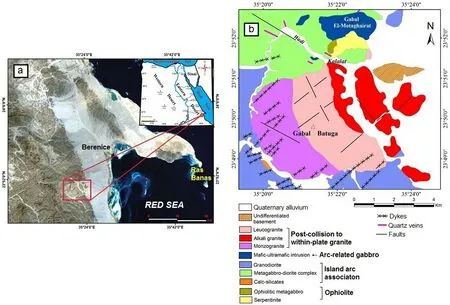
Fig.1 a Location map of the study area.b Geological map of the Wadi Kalalat area modified after El Sobky et al.(2020)
Based on extensive field work,the Gabal El Motaghairat mafic–ultramafic intrusion is approximately ellipticalshaped(Fig.1).The majority of its lithologies are massive,dark brown or black,and with no evidence for either metamorphism or deformation.In some instances,the most prominent feature is rhythmic layering of different scales and gradation with a typical consisting of basal ultramafic peridotite overlain by light-colored or leucocratic lithology.The field work,confirmed by the petrography (next section),indicates this leucocratic variety is anorthositic gabbro and not anorthosite as previously suggested by Abdel Halim et al.(2016).The mafic–ultramafic intrusion is dissected by a set of NW-trending aplite dykes and barren quartz veins (Fig.2a,b).The country rocks for the Gabal El Motaghairat mafic–ultramafic intrusion include serpentinite and a metagabbro-diorite complex.The mafic–ultramafic intrusion itself is intruded by apophyses of the Batuga younger granites,especially along the southern bank of the Wadi Kalalat (Fig.1).The Batuga granite led to the formation of a narrow contact aureole(0.70–1.15 m wide) for the southwestern contact of the Gabal El Motaghairat mafic–ultramafic intrusion leading in the formation of a coarse melanocratic gabbro with distinct hornfelsic texture.This hornfelsic melagabbro is hard,silicified and exhibit pegmatitic appearance as hornblende crystals reach up to~4.5 cm.

Fig.2 a Aplite dyke (Ap) intruding the Gabal El-Motaghiarat peridotite.b Barren quartz vein (Qz) in the olivine gabbro.c Spheroidal weathering of fresh olivine gabbro.d Dyke-like body of olivine gabbro intruding the island arc association,photograph looking SW.e,f Layering in leucocratic/anorthositic gabbro
The basal peridotite is coarse-grained and has very fresh crystals of pyroxene with an average length of 0.65 cm.The outcrops with no layering are characterized by coarsegrained gabbro that displays boulder weathering(Fig.2c).In some instances,the gabbro occurs as dykes within the main mass of the intrusion (Fig.2d).The rhythmic layers in the intrusion are shallow dipping (21–33° NW) and range in thickness,mostly from~0.85 to~12 cm(Fig.2e,f).Towards the top of the section,the leucocratic layers are represented by the anorthositic gabbro with visible cumulus fabrics.Although is coarse-grained,micro-layering is evident within an individual layer.
Figure 3a is a general view of the Gabal Batuga granitic intrusion in which the main granitic mass is represented by leucogranite and alkali feldspar granite (Fig.3a).The intrusion is approximately circular in outline (Fig.1),forming highly mountainous rugged topography,and displays sharp intrusive contacts with the older island-arc metagabbro-diorite association to the south of the Wadi Kalalat main stream (Fig.3b).Some small outcrops show the Batuga granite intruding along the northeastern part of the area at the mouth of the wadi traversing the ophiolitic serpentinite (Fig.3c).Based on our field work supported by remote sensing data,the authors subdivide the granitic rocks of the Gabal Batuga pluton into three varieties,namely (1) monzogranite,(2) cataclastic garnetiferous leucogranite and (3) alkali feldspar granite.
Based on the field relationships along lithological contacts,it is evident that the monzogranite is the oldest variety and it represents the western lobe of the pluton.It is pink,coarse-grained,exfoliated and is intruded by a second granitic variety or the leucogranite termed as ‘‘biotite granite’’ in the field.Any possible thermal effect of the monzogranite on the metagabbro-diorite country rocks was disrupted and obliterated by the intrusion of the second pulse of the Batuga granite contains garnet and is characterized by cataclastic txture.This garnetiferous variety is medium-to coarse-grained,leucocratic and represents the central lobe of the intrusion.The eastern lobe represented by the alkali feldspar granite show clear intrusive contact against the leucogranite and in some instances,there are few xenoliths of the former in the latter.No shield margins are observed but in few cases a gradational contact can be seen.The alkali-feldspar granite is the most weathered granitic variety and is bounded from south by low hills of island-arc metadiorite and granodiorite.At some outcrops,the alkali-feldspar granite encloses fragments of metagabbro and metadiorite suggesting an intrusive relatioship.Dykes of different composition intrude the three lobes of the Batuga granite(Fig.3d,e)and locally the island-arc rock association.These dykes are either mafic or felsic.The majority of mafic dykes and follow a NE–SW trend occur as resistant ridges where they intrude the island-arc rocks,in the majority of them intrude the Gabal Batuga pluton and the post-granitic dykes.Generally,the mafic dykes are fine-grained,black to greenish black,jointed and are locally off-set by normal faults.Some mafic dykes contain coarse pyrite crystals(up to 0.6 cm),vary in width from tens of centimeters to few meters,and are several kilometers in length.Felsic dykes are represented by aplite and microgranite/granophyre.The aplite dykes intrude most of the island-arc association as well as the Gabal El Motaghairat pluton,as well as the younger granites (Fig.3e).The aplite is extremely fine-grained,highly fractured and sheared in parts(Fig.3f).Major trends of the felsic dykes are NE-SW and E-W,and their width ranges from few centimeters to few meters.
2.2 Petrography of the intrusive rocks
The petrographic description of the studied intrusive rocks includes (1) the Gabal El-Motaghiarat mafic–ultramafic intrusion,(2) the Gabal Batuga granite intrusion,and (3)the dyke rocks.Modal analysis of coarse-grained rocks is provided (Table 1).
2.2.1 Mafic–ultramafic rocks
Ultramafic rocks are dominated by peridotite,which is coarse-grained and consists of pyroxene (mostly diopside and much lesser enstatite),olivine and minor inter-cumulusplagioclase (An88-95).Brown spinel and pyrrhotite are common accessories.
Two varieties of olivine gabbros are distinguished.Hornfelsic melagabbro variety is composed of olivine,pyroxene (augite &hypersthene),plagioclase,hornblende,biotite and epidote.Recrystallized inter-cumulus plagioclase encloses pyroxene(Fig.4a).Pyroxene is coarse,fresh and it shows occasional exsolution of thin clinopyroxene lamellae along the cleavage planes Augite shows interstitial fabrics against recrystallized opaque minerals(Fig.4b).Olivine is lesser in abundance and most of the olivine the grains show extensive replacement by serpentine along cracks.Hornblende shows hornfelsic and pegmatitic textures either in the hand specimen or microscopically.Minor inter-cumulus biotite shows reaction relationship against pyroxene along peripheries(Fig.4c).Opaque minerals (~6–8%) are mostly represented by extremely fresh inter-cumulus hematite-ilmenite exsolution intergrowth.There is some recrystallized interstitial ilmenite with some exsolved hematite laminae(Fig.5a).Much lesser and finer homogeneous magnetite is present either as oriented fine crystals along cleavage of pyroxene or as homogeneous crystals,showing low-temperature oxidation (martitiation),that are sometimes seen intimately associated with colloform goethite after a preexisting pyrite (Fig.5b).Common gold grains of variable size are recorded (Fig.5c).
Olivine gabbro is coarse-grained,inequigranular and consists mainly of plagioclase (An70-75),augite,olivine,biotite,hornblende and rare hypersthene.Secondary minerals are sericite,chlorite and serpentine.Olivine is cumulus and granular (Fig.4d),and is partly altered to serpentine along cracks forming typical mesh texture.The plagioclase is coarse,slightly sericitized and may contain inclusions of hornblende.A second generation of hornblende is coarse and it is partly altered to chlorite and biotite.Augite is partly altered to hornblende forming a corona like texture (Fig.4e),or slightly altered to form bastite.Quartz and biotite are interstitial.The modal abundance of opaque minerals vary from~1 to 8%.Opaque minerals are represented by sulfide and Fe-Ti oxides,which are predominantly represented by ilmenitehematite intergrowth (Fig.5d).The intergrown hematite takes the form of minute oriented worm-like or spindleshaped crystals or as thin parallel bands.Some homogeneous magnetite is seen but composite sandwich ilmeno-magnetite is also present.The sulphide minerals are mostly pyrrhotite with subordinate amount of chalcopyrite.Pyrrhotite occurs outside the olivine crystals.Colloform goethite is present and it is associated with gold occasionally(Fig.5e).The majority of pyrrhotite crystals are hydrated to goethite along cleavage planes and peripheries(Fig.5f).
Anorthositic gabbro is a leucogabbro rich in plagioclase(An73-80),with subordinate hypersthene,hornblende,Fe-Ti oxides,sulfides with subordinate actinolite and epidote(zoisite,rare pistachite).It shows some remarks of deformation (e.g.bending) and interlocking fabrics are very distinct (Fig.4f).Compositionally,the pyroxene is hypersthene.This hypersthene displays sub-ophtic textures and is interstitial.Opaque minerals (~5–6%) are represented by sulphides and Fe-Ti oxides in nearly equal amounts.The sulfides (pyrrhotite and chalcopyrite) are either homogeneous or form a composite intergrowth.They are altered to goethite and chalcocite-covellite,respectively,especially along their rims.The Fe-Ti oxides(magnetite and ilmenite)are mostly intergrown but few homogeneous crystals can be also seen.In some samples,the intergrowths are represented by sandwich or composite ilmeno-magnetite.
2.2.2 Granitic rocks
Leucocratic monzogranite consists essentially of orthoclase and microcline,plagioclase,quartz as well as muscovite and biotite.Potash feldspar is represented by microcline perthite and homogeneous orthoclase that occur as medium-or coarse-sized subhedral crystals (Fig.6a).Plagioclase is coarse,sub-prismatic,slightly z0ned,slightly deformed with oriented sericite alteration,and host inclusions of muscovite.Quartz occurs as interstitial grains with characteristic wavy extinction.Mafic minerals are predominated by biotite.Also,white mica is present (muscovite) that partly corrodes feldspar.Orthoclase is partly altered to granular epidote.Opaque minerals are relatively low in abundance (~2–3%) and they are represented by Fe-Ti oxides.The latter comprises fresh homogeneous ilmenite and hematite-ilmenite intergrowth with slighttitanite peripheral alteration.Slightly martitized magnetite is present but uncommon.
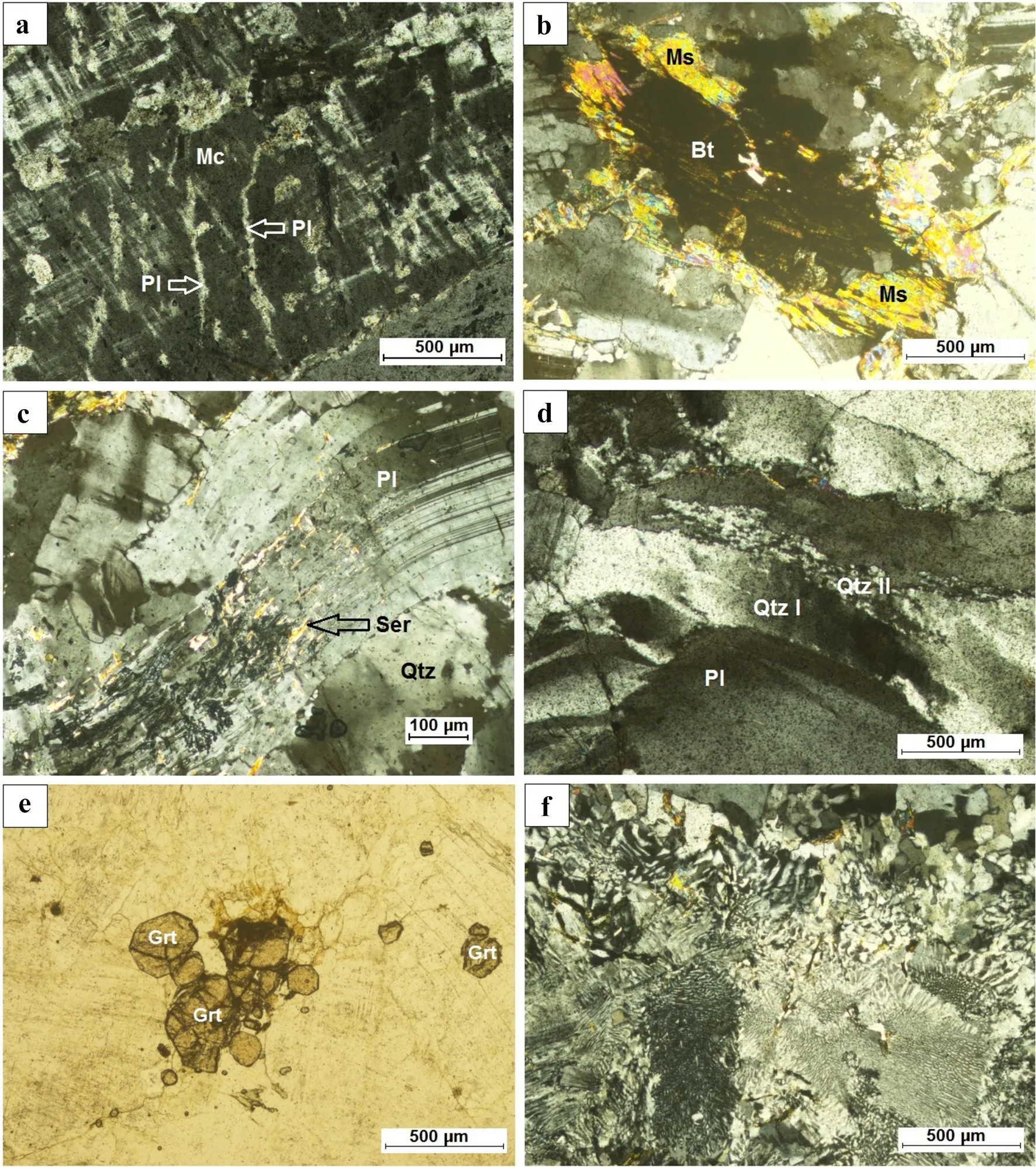
Fig.6 Petrography of the Gabal Batuga younger granites.a Typical microcline perthite,CN.b Muscovitized (Ms) biotite (Bt) flakes,CN.c Undulose extinction of quartz (Qz) and openly folded plagioclase (Pl) with some sericite (Ser) alteration,CN.d Cataclazed granite with microcrystalline silica between coarse quartz clasts(Qtz),CN.e Euhedral to subhedral garnet(Grt),PPL.f Graphic texture in the Batuga granite,CN
Garnet-bearing leucogranite ismoderately to highly cataclased,slightly altered and inequigranular. It is composed of plagioclase,quartz, perthitic microcline, biotite and muscovite. Biotite is presentin the form of coarse flakes, which displays muscovitization(Fig. 6b). Plagioclase is coarse, subhedral, sub-prismatic,deformed, corroded by muscovite stained by iron oxides andhydroxides. Some plagioclase grains are bent as result of deformationand are slightly sericitized along the twinning lamellae(Fig. 6c). Mostly, microcline forms micro-perthite intergrowth.Quartz is represented by twogenerations (primary and secondary);primary quartz is coarse and secondary quartz is microcrystallineas silica veinlets along cracks resulting from cataclasis (Fig. 6d).Garnet (spessartine) occurs as euhedral to subhedral crystals(Fig. 6e) that are occasionally segregated into aggregates.Opaqueminerals are scarce (~ 2%) and they are represented only byhomogeneous, fresh magnetite with very slight martitization.
Alkali-feldspar granite is leucocratic,medium-to coarsegrained and with evidence of very minor or no cataclasis.This rock is composed essentially of alkali feldspar(mainly perthite),plagioclase,quartz,biotite and muscovite.Alkali feldspars occur as subhedral to anhedral prismatic crystals.They are slightly deformed and represented by perthite,orthoclase and microcline perthite.Also,the rock is characterized by a very diagnostic graphic texture(Fig.6f).Quartz occurs as coarse crystals and as minor microcrystalline grains along the cracks of coarse K-feldspar.Plagioclase is coarse with some sericite veinlets along cracks.Biotite occurs as flakes that are partly altered to chlorite.Opaqueminerals(~2–3%)andarerepresentedbyfine magnetite only that exhibits some alteration to martite.
2.2.3 Dyke rocks
The mafic dykes are mostly diabase consisting of plagioclase (An82-87) forming porphyritic crystals embedded inan apatite-and augite-rich groundmass.Plagioclase in some andesitic basalt samples (An53-57) displays distinct zoning and glomeroporphyritic (Fig.7a) or doleritic texture (Fig.7b).Frequency of the granophyre dykes in the main mass of the Batuga granite is sub-ordinate if compared to the common basalt,andesitic diabase and aplite.Granophyre texture is very common (Fig.7c).Aplite is leucocratic,fine-to medium-grained and equigranular.The aplite consists of plagioclase and quartz micro-phenocrysts set in a very fine groundmass rich in quartz and sericite,which gives the rock its saccharoidal nature (Fig.7d).
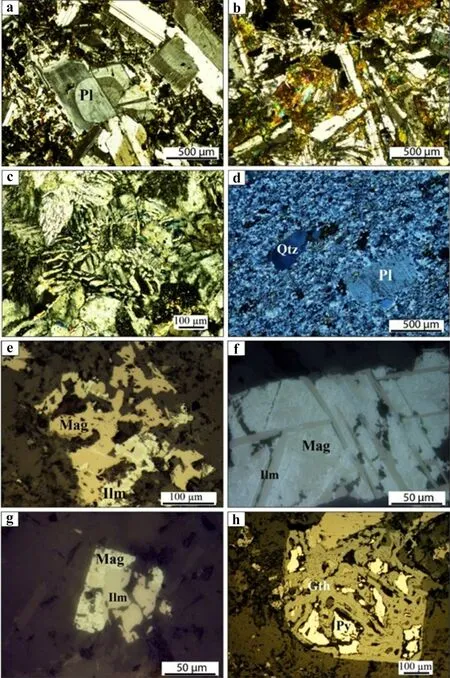
Fig.7 Petrography of the dyke rocks.a Zoning in plagioclase phenocryst(Pl),andesitic basalt,CN.b General view of diabase/dolerite texture,andesitic basalt,CN.c Fresh skeletal ilmenite (Ilm)associated with partly martitized magnetite (Mag) in andesitic basalt.d Coarse-trellis ilmeno(Ilm)-magnetite (Mag)intergrowth in andesitic basalt.Notice martitization of the magnetite host in the basalt.e Composite ilmeno-magnetite intergrowth in the andesitic basalt.f Colloform goethite(Gth) with island-like relics of pyrite (Py) in andesitic basalt.Notice the presence of ilmenite(Ilm) adjacent to oxidized sulphide
The diabase has a considerable amount of opaque minerals(7–17%),represented by homogeneous magnetite,homogeneous ilmenite,hemo-ilmenite and pyrite.Ilmenite occurs as thin prisms that are mainly skeletal.Sometimes,fresh skeletal ilmenite occurs adjacent to partly martitized magnetite(Fig.7e).Hemo-ilmenite crystals are present but uncommon.Homogeneous magnetite is coarse,skeletal,slightly martitized and it encloses rounded to sub-rounded inclusions of silicate minerals.The ilmeno-magnetite intergrowth is common (composite and coarse-trellis)(Fig.7f,g).In some dykes of andesitic basalt,pyrite is common~15% of the opaque content.Pyrite occurs as coarse cubes (up to 2 mm wide) that is extensively altered to goethite forming typical colloform texture (Fig.7h).
2.3 Geochemistry
2.3.1 Gabal El Motaghairat mafic–ultramafic intrusion
Whole-rock geochemical data of the mafic–ultramafic rocks from the Motaghairat pluton (Table 2) indicate wide variations in the chemical composition as a function of lithological variations (peridotite,olivine gabbro,hornfelsic melagabbro and anorthositic gabbro).Peridotite and olivine gabbro have narrow variations in major oxides and both are characterized by a low loss on ignition(LOI)value(1.2–4.5 wt%).The hornfelsic melagabbro is characterized by remarkable increase of SiO2,Na2O and K2O significantly higher (63.3 wt%,2.4 wt% and 2.1 wt%,respectively).The total alkali oxides versus silica or the so-called‘‘TAS diagram’’ of Cox et al.(1979) classifies the investigated peridotite samples at the basal parts of the intrusion as ultrabasic rocks while the olivine gabbros are plot as basic to intermediate members (Fig.8a,c).The hornfelsic melagabbro plots along the boundary separating intermediate to acidic composition,consistent with the view that this rock represents a hybrid or metasomatized rock inside the contact aureole (Fig.4a).
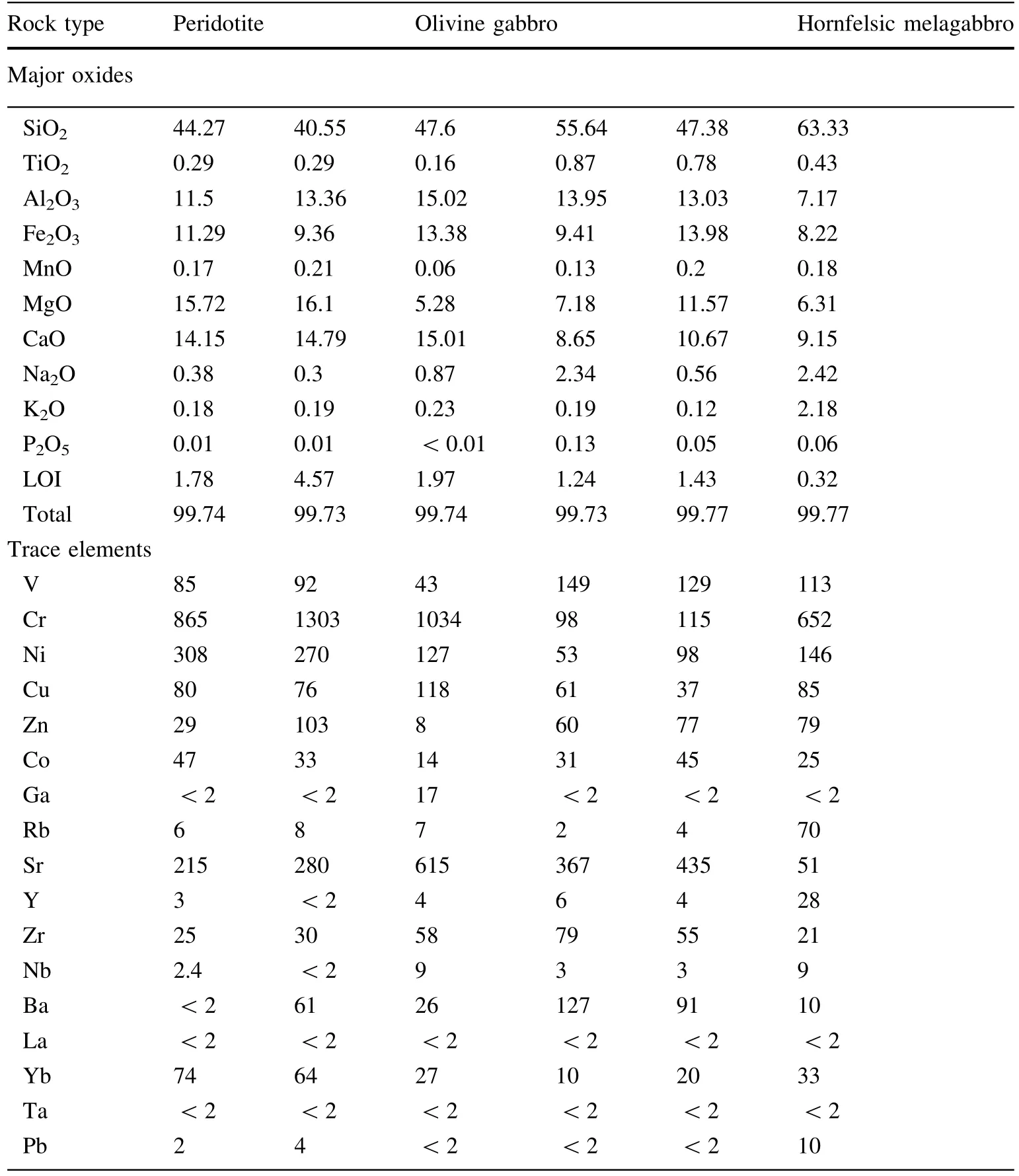
Table 2 Major oxides (wt%)and trace elements (ppm)analyses of the fresh mafic–ultramafic rocks
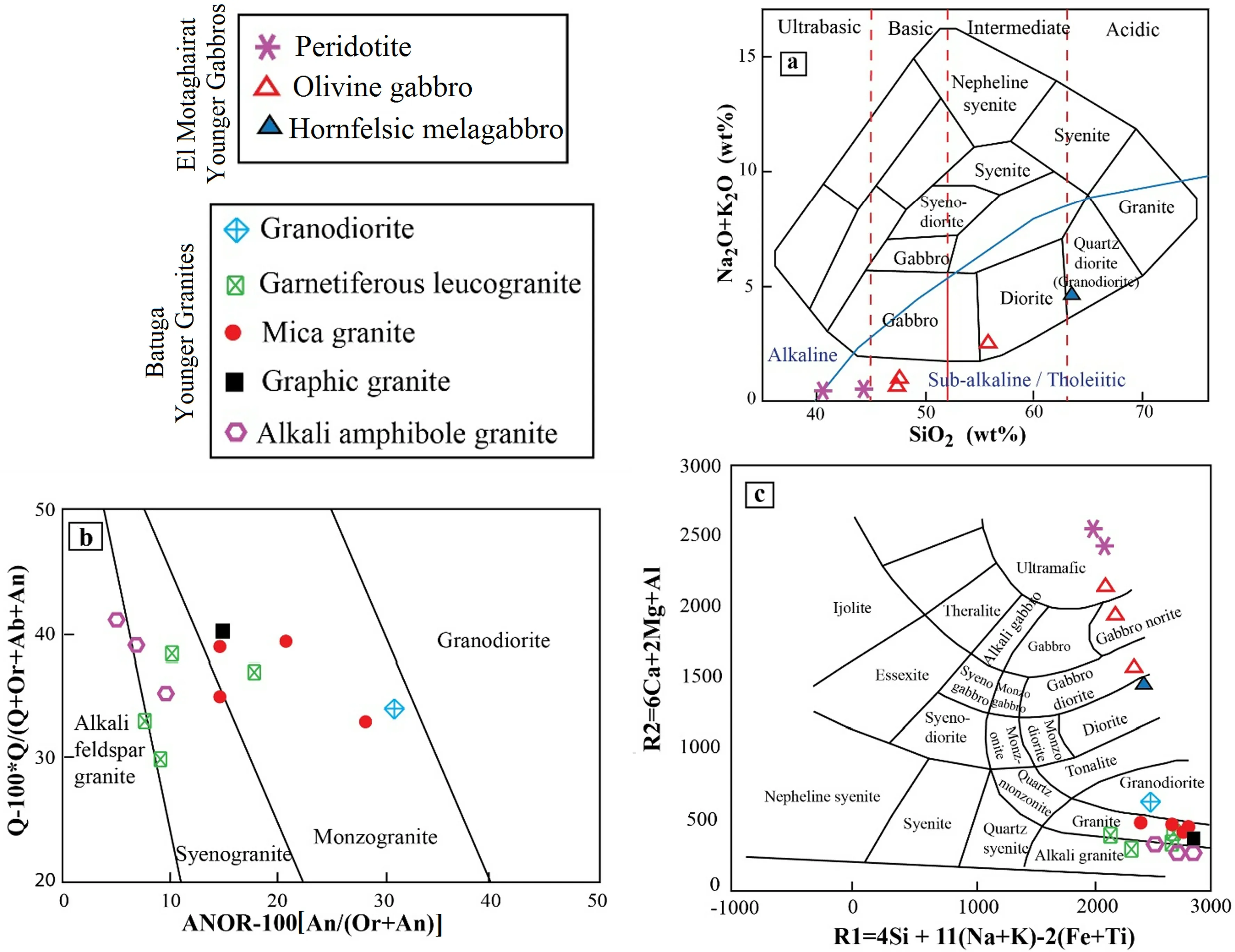
Fig.8 a Classification of the fresh mafic–ultramafic rocks from El Motaghairat pluton using the total Alkali Oxide-Silica(TAS)diagram of Cox et al.(1979)adopted by Wilson(1989).b ANOR-Q’normative plot of Streckeisen and Maitre(1979)for the classification of the Gabal Batuga younger granites.Adopted by Whalen and Frost(2013)for the trends of granitic rocks from different magma compositions.c R1–R2 plot of De la Roche et al.(1980) to classify the studied younger gabbros and younger granites
The Harker’s variation diagrams of SiO2and MgO versus some major oxides reveal that the gabbro shows a systematic increase of CaO and Fe2O3with increasing SiO2and on the other hand a decrease of Na2O+K2O with increasing SiO2.The anorthositic gabbro can be distinguished from olivine gabbro by its higher CaO (15.01 wt%),Al2O3(15.02 wt%),Ni (127 ppm) and Cr (1034 ppm),and lower MgO(5.28 wt%),Co(14 ppm)and Ba(26 ppm) (Supplementary File #1).
2.3.2 Gabal Batuga granitic intrusion
Younger granites from the Gabal Batuga intrusion are classified as mica granite (monzogranite),garnetiferous leucogranite and alkali feldspar granites.Sub-varieties of the latter are alkali amphibole and graphic granite.Very minor granodiorite also exists.A sum of 13 granite samples from the Gabal Batuga intrusion were analyzed for their major oxide and trace element compositions (Table 3).Using the ANOR-Q’ normative plot of Streckeisen and Maitre (1979),with modification by Whalen and Frost(2013),indicates that the mica granite,graphic granite,granodiorite and one sample of garnetiferous leucogranite plot in the monzogranite field,two samples of the alkali amphibole granite and three samples of the garnetiferous leucogranite plot in the field of syenogranite,and one sample from garnetiferous leucogranite plots in the alkali feldspar granite field (Fig.8b).The R1–R2plot of De la Roche et al.(1980) classifies the samples of mica granite,graphic granite and garnetiferous leucogranite as typical granite.The granodiorite sample falls in the granodiorite field whereas the amphibole granite samples and one sample of the mica granite plot in the field of alkali feldspar granite (Fig.8c).
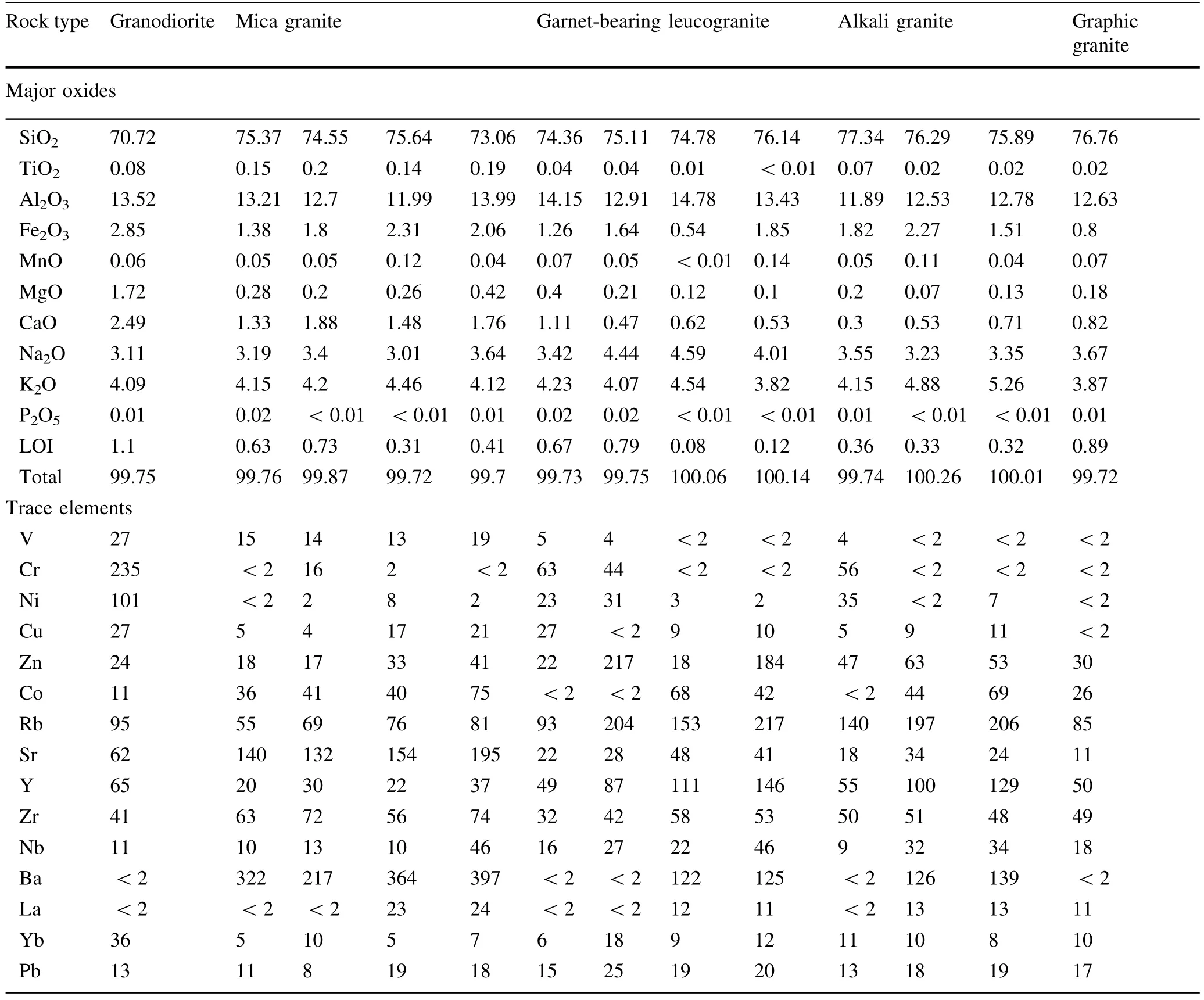
Table 3 Major oxides (wt%) and trace elements (ppm) analyses of the younger granites
Analyses of the Batuga younger granite samples revealed a relatively narrow range of SiO2(73.0–77.3 wt%),Al2O3(11.8–14.7 wt%),CaO (0.3–1.8 wt%),MgO(0.1–0.4 wt%),Fe2O3(0.5–2.3 wt%),Na2O (3.0–4.5 wt%)and K2O (3.8–5.2%),except for the granodiorite sample,which has a higher content of MgO (1.7 wt%),Fe2O3(2.9 wt%) and low SiO2(71 wt%).Variation of major oxides and trace elements versus SiO2are shown on the Harker diagrams(Supplementary File#1).Generally,major oxides exhibit semi-continuous trends as Fe2O3,CaO and MgO decrease with increasing SiO2.Trace element correlation with SiO2shows no trends.The mica granites have high contents of Sr,Zr and Ti,but low Rb.On the other hand,the garnetiferous leucogranite and alkali amphibole granite have low Sr,Zr and Ti,but a slightly high content of Rb.
2.3.3 Dyke rocks
Three samples of mafic dykes and two samples of felsic dykes (granophyre and aplite) were analyzed to determine the contents of major oxides and some trace elements(Table 4).Analyses of the mafic dykes show narrow variations in major oxides,e.g.SiO2(50.2–51.9 wt%),Al2O3(10.5–11.8 wt%),CaO (6.9–10.1 wt%),Fe2O3(14.1–16 wt%),MnO (0.15–0.2 wt%),MgO (3.1–7 wt%),Na2O(1.8–2.9 wt%),K2O(0.5–1.1 wt%),in contrast to the felsic dykes.The TAS diagram of Le Bas et al.(1986) is used to confirm the field and petrographic nomenclatures.The mafic dykes fall in the field of basalt and have tholeiite to slight alkaline affinity (Supplementary File #2).
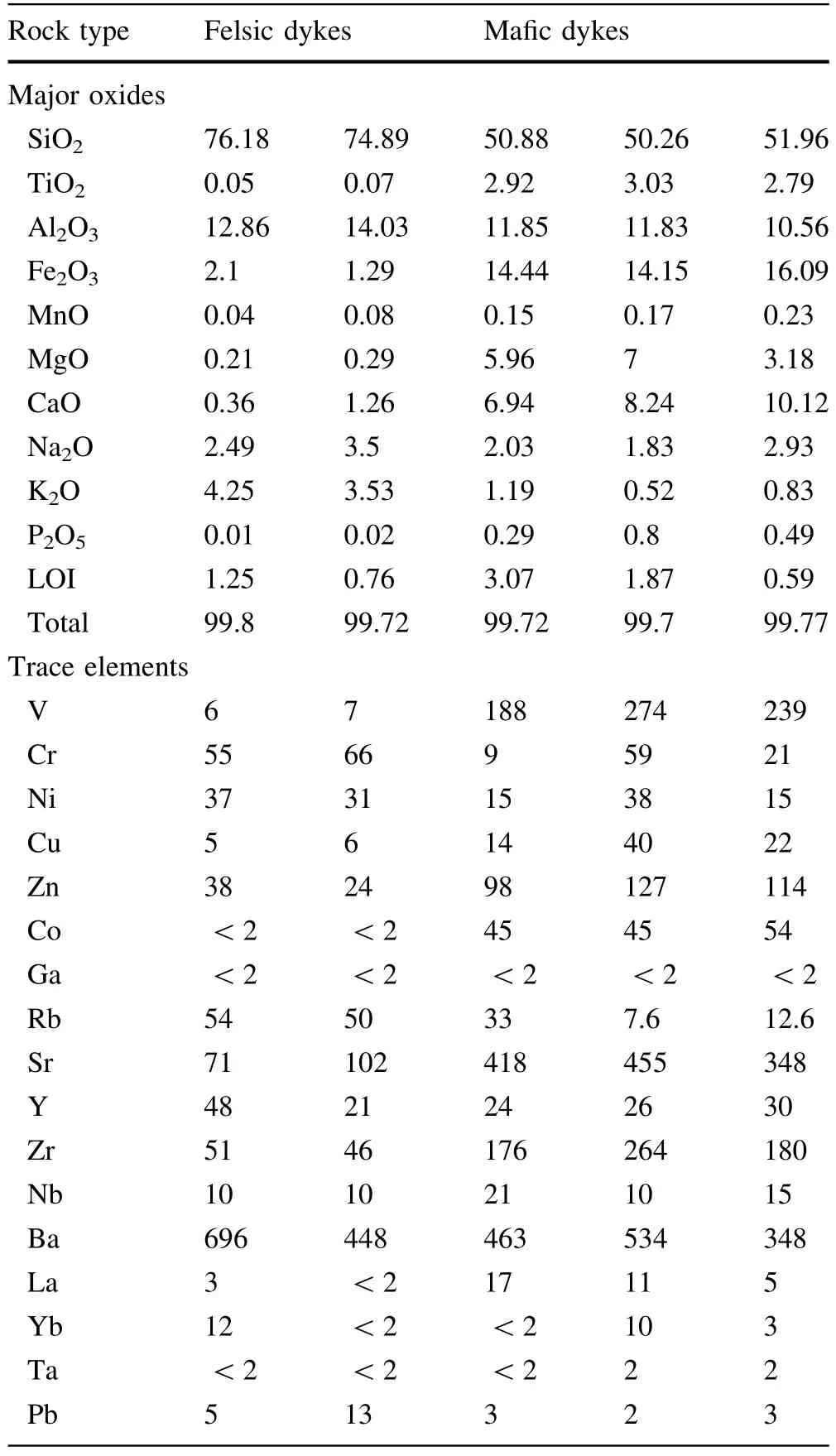
Table 4 Major oxides (wt%) and trace elements (ppm) analyses of the felsic and mafic dyke
3 Discussion
3.1 Magma type and tectonic setting
The AFM diagram of Irvine and Baragar (1971) is used to determine magma type of the intrusive mafic–ultramafic rocks from the Motaghairat pluton.Figure 9a indicates crystallization from tholeiitic magma.On the MgO-FeOt-Al2O3ternary diagram of Pearce et al.(1977),most samples fall in the field of oceanic island arc (Fig.9b).On the discrimination diagram of Miyashiro and Shido (1975),which relates Ni and Ba with FeOt/MgO ratio (Fig.9c,d),the majority of olivine gabbro samples are confined to the field of island arc intrusions,whereas the hornfelsic melagabbro falls within the abyssal tholeiite field.

Fig.9 Magma type and tectonic setting of the Gabal El Motaghairat younger gabbros.a FeOt–MgO–Al2O3 ternary diagram of Pearce et al.(1977).b,c Tectonic setting of mafic rocks based on ratio of ferromagnesian oxides versus Ni (a) and Ba (b) of Miyashiro and Shido (1975),respectively.Symbols are as in Fig.8
As for the Batuga intrusions,the SiO2versus K2O diagram of Peccerillo and Taylor (1976) (Fig.10a) suggests that they represent a high-K calc-alkaline series.On the SiO2versus Na2O+K2O–CaO plot of Frost et al.(2001),most samples fall in the calc-alkaline field (Fig.10b).The majority of the Batuga younger granite samples fall in the ferroan field on the SiO2versus FeOt/(FeOt+MgO) plot of Frost et al.(2001),except for the granodiorite sample and one sample of the garnetiferous leucogranite,which are‘‘magnesian’’ (Fig.10c).One of the most useful ways to discriminate different granitic types is by use of the molar ratio Al2O3/(Na2O+K2O+CaO) which has been referred to as A/CNK and the alumina saturation index(ASI)by Maniar and Piccoli (1989).Using this relationship,the Batuga younger granites are mostly peraluminous with only two samples(a granodiorite and a mica granite)show a slightly metaluminous character(Fig.11a).On the binary B versus A diagram of Debon and Fort(1983)modified by Villaseca et al.(1998),(Fig.11b),most samples are low to moderately peraluminous field except for the graphic granite sample and a garnetiferous leucogranite sample,which plot in the felsic peraluminous field.Two samples of granodiorite and mica granite are confined to the metaluminous field.
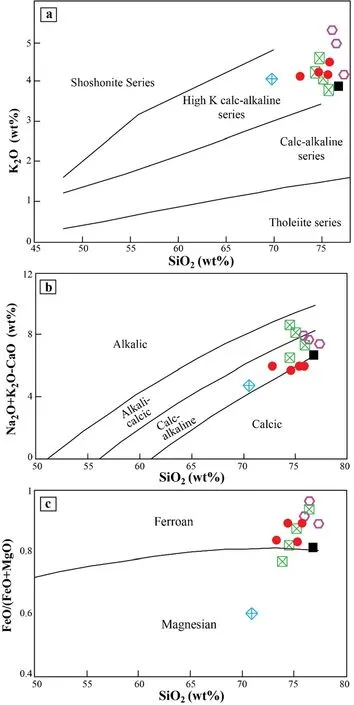
Fig.10 Magma type of the Gabal Batuga younger granites.a SiO2 versus K2O(Peccerillo and Taylor 1976).b SiO2 versus Na2O+K2-O–CaO (Frost et al.2001).c SiO2 versus FeO/(FeO+MgO) (Frost et al.2001).Symbols are as in Fig.8

Fig.11 Magma composition of granites from the Gabal Batuga granites with respect to enrichment of alumina: a B-A plot of Debon and Fort(1983)modified by Villaseca et al.(1998)where f-P,h-P,m-P and l-P are felsic high-,medium-,and low-peralumious granitoids,respectively.b Aluminum saturation index as molar Al2O3/Na2O+K2O+CaO(ASI)-molar Al2O3/Na2O+K2O (A/KN) (after Maniar and Piccoli 1989).Tectonic setting: c,d trace elements discrimination diagrams (Pearce et al.1984).Symbols are as in Fig.8
The Rb versus(Y+Nb)diagram of Pearce et al.(1984)is based essentially on fluid-immobile high field strength elements(Y and Nb)against one of a fluid-mobile large ion lithophile element(Rb).All the Batuga granite samples fall in the within-plate granite field,except for a mica granite sample that falls in the field of volcanic arc granite(Fig.11c).Y+Nb content increases in rocks with higher Rb contents suggesting their evolution by crystallization of anhydrous phases (Pearce 1996).On the Y versus Nb(ppm)diagram of Pearce et al(1984),the mica granite and aplite dyke samples plot in the field of volcanic arc&syncollision granite whereas the garnetiferous leucogranite,alkali amphibole granite and graphic granite samples plot in the field of within-plate granite.The granodiorite and one sample of alkali amphibole granite plot in the field of orogenic granite whereas a granophyre dyke is plotted at the boundary between volcanic arc and orogenic granite(Fig.11d).
Plots of the chemical analyses of the dykes on the SiO2versus Na2O+K2O diagram (Irvine and Baragar 1971)illustrates that the samples fall in the tholeiitic and calcalkaline fields (Supplementary File #2).On the AFM diagram,the basalt samples mainly display a tholeiitic signature whereas the felsic dykes plot in the calc-alkaline field.The ternary discrimination diagram Ti/100-Zr-3*Y of Pearce and Cann (1973) shows that the mafic dykes are within-plate basalt,and this is supported by the Zr–Zr/Y binary plots of Pearce and Norry (1979),and Zr-Ti of Pearce (1982) as shown in the Supplementary File #2.The ternary diagram (Na2O+K2O) -(Fe2O3t*5) -(CaO+MgO) of Grebennikov (2014).The granophyre sample falls in the field of A1-type granite(silicic rocks of within-plate geodynamic setting: oceanic island and continental rifts),whereas the aplite sample falls in the field of A2-type granite (silicic rocks of post-collisional and latecollisional geodynamic setting.On the Y+Nb versus Rb and Y versus Nb binary diagrams of Pearce et al.(1984),the aplite plots in the volcanic arc granite field whereas the granophyre falls along the boundary between volcanic arc granite and within-plate granite fields.On the other hand,aplite on the Y versus Nb plot falls in the volcanic arc and syn-collision granite field whereas the granophyre falls along the boundary between volcanic arc and syn-collision granite field and orogenic granite field.
3.2 Behaviour of trace elements: thermal metamorphism and magma evolution
Here the authors distinguish between possible crustal contamination of the magma from which the Gabal El Motghairat mafic–ultramafic intrusion was formed,and the geochemical modification of the gabbro due to the thermal effect by the Gabal Batuga granite.Based on the data in Table 1,it is evident that the hornfelsic melagabbro inside the contact aureole has anomalously high contents of some large ion lithosphile elements (LILEs) such as Rb and Y(70 ppm and 28 ppm,respectively),due to the invasion of fluids from the felsic intrusion.This indicates that thermal metamorphism happened when the granite was still wet and partially unconsolidated.On the other hand,Rb and Y in the peridotite and gabbro,which has not been thermally affected lies in the ranges 2–8 ppm and <2–6 ppm,respectively.The gabbro does not exhibit the increase in SiO2,Al2O3,Na2O and K2O in the hornfelsic melagabbro(63.33 wt%,7.17 wt%,2.42 wt% and 2.18 wt%,respectively).
Due to the low content of hydrous minerals and the remarkably low LOI content(0.32–1.97 wt%)in the Gabal El Motaghiarat gabbro and peridotite,it seems that mobility of trace elements was limited in case of one peridotite sample with 4.57 wt% LOI because at least the LILEs were not affected in this sample by some alteration to serpentine minerals.Therefore,the present authors do not agree Abdallah et al.(2019) that the arc or younger gabbros in the Eastern Desert are depleted in LILEs upon partial serpentinization.On the other hand,the present authors agree with them that our Egyptian arc gabbros were generated from mafic magma that suffered from early event of melt extraction as indicated by the extremely low Ta <2 and 9 ppm Nb content.This event of melt extraction is possible only if the Nb/Ta ratio lies in the range 2–15 (Polat and Hofmann 2003).Our data support the conclusion of Abdel Halim et al.(2016) that the Gabal El Motaghiarat mafic intrusion represents an Alaskan-type intrusion similar to some of the younger gabbros in the Eastern Desert of Egypt(e.g.,Helmy et al.2015;Abdallah et al.2019).This is also consistent with the general concept of low Nb in the igneous rocks derived from a mantle source in the Arabian–Nubian Shield and elsewhere in similar shields in the world(e.g.,Shaw et al.2007;Maurice et al.2013;Helmy et al.2014;Su et al.2014;Abdel Halim et al.2016;Gamaleldien et al.2021a,b).The spider diagrams (Fig.12) of the Gabal El Motaghiarat gabbro and peridotite indicate a normal fractionation and differentiation trend of mafic magma source regardless of whether they are normalized to chondrites,primitive mantle or midocean ridge basalt (MORB).The positive Ba and Sr anomalies support the freshness of the calcic plagioclase whereas the depletion in Zr indicates negligible contamination of the mafic magma with some crustal materials upon the emplacement of magma (Plank 2005;Yang and Zhou 2009).Figure 12 also show the clear discrimination between hornflesic melagabbro and the gabbros outside the thermal aureole).
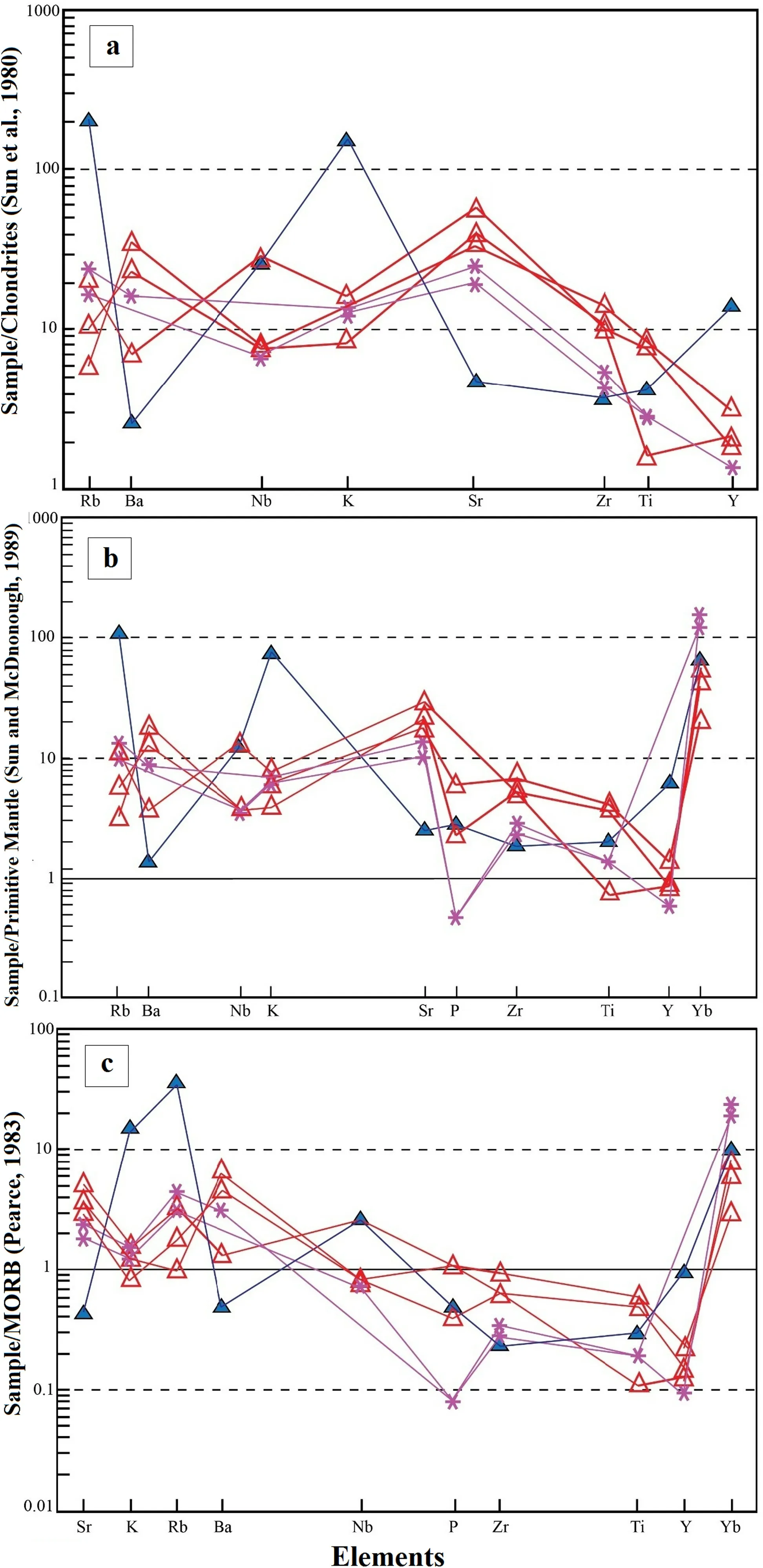
Fig.12 Spider diagrams of the Gabal El Motghairat mafic–ultramafic intrusion (younger gabbros).Normalizing values belong to chondrites,primitive mantle and mid-ocean ridge basalt (MORB) from Sun et al.(1980),Sun and McDonough (1989) and Pearce (1983),respectively.Symbols are as in Fig.8
The Gabal Batuga younger granites show similar geochemical characteristics to many younger granites in Egypt,either I-or S-type(Farahat et al.2007).The Batuga younger granites have considerable contents of Fe and K(Table 2,Fig.10c) indicating they are highly fractionated granites that formed from fractionation of the magma derived from melting continental crust melt rather than by a melt from the mantle.The spider diagrams of the Batuga younger granites (Fig.13) show relative enrichment of K,Rb and Sm and a prominent Ti negative anomaly prominentsupports fractionation of felsic magma derived from melting continental crust.The Harker diagrams suggest that the three pulses of felsic magmatism at Gabal Batuga are co-magmatic (Supplementary File #1).The generated magma is highly potassic (Fig.10a) and likely formed by fractional crystallization without any kind of alkali metasomatism (Heikal et al.2019).The majority of the Batuga younger granites formed as crustal type rocks based on their Nb,Y and Ce contents and accordingly are considered as post-collisional A2-subtype with few A1-subtype of Eby(1992) similar to some transitional Egyptian younger granites in Egypt that develop in post-collisional and within-plate settings (e.g.,El-Bialy and Omar 2015).This is consistent with similar terrains elsewhere in the world in which the granitic series range from arc to within-plate passing through a post-collisional phase (e.g.,Bonin 2007;Frost and Frost 2011;Yang et al.2017;Gamaleldien et al.2021a,b;Khudeir et al.2021).
3.3 History of igneous activity at the Wadi Kalalat area
Generally,younger gabbros in Egypt either in the Eastern Desert or Sinai,are fresh,not metamorphosed and occur as layered intrusions in most cases (Basta 1988;Ghoneim 1988;Essawy et al.1997;Abdel-Karim et al.2011).These magmas are diverse in composition from tholeiitic to calcalkaline emplaced in arc and within-plate settings (e.g.,Abu El Ela 1991;Abu Anbar 2001;Mohamed and Hassan 1996;Abdel-Karim et al.2011;Azer et al.2016,2022).Heterogeneity of the lithosphere beneath the Arabian–Nubian Shield resulted in the grouping of the younger gabbros into Alaskan-type(rich in PGE)and non-Alaskantype (rich in Fe-Ti ores) (Abdel-Gawad 2002;Khedr et al.2020,2022).The Gabal El Motaghiarat intrusion falls in the Alaskan-type group.Based on the data presented herein,mafic magmatism beneath the Wadi Kalalat area is typical of an arc setting,a conclusion consistent with the findings of Abu El-Ela(1984)and El-Haddad et al.(1984).Mineralogy and geochemistry of the Gabal El Motaghairat mafic–ultramafic intrusion show evidence of magma formed by fractionation of an asthenospheric mantlederived melt during the incipient stage of the arc evolution.The present authors propose that the mantle-derived tholeiitic magma was emplaced in an active continental margin setting as the arc matured(e.g.,Abdel-Karim et al.2011;Surour et al.2017).Another pulse of mafic magmatism that formed gabbros was calc-alkaline in composition and represents typical post-collisional magmatism in the Arabian–Nubian Shield (e.g.,Madbouly 1991;Azer and El-Gharbawy 2011;Azer et al.2022).Our results support the concept that the Gabal El Motaghairat gabbros are Alaskan-type formed in a typical arc setting from a subduction-related magma,has been proposed for similar bodies in the Arabian–Nubian Shield(e.g.,Abd El-Rahman et al.2012;Abdallah et al.2019).Although these post-collisional gabbros form in the extensional stage of shield formation,in some cases they maintain signatures of arc-like magma (e.g.,Ali and Alshammari 2021) but in other cases this signature is negligible (e.g.,Eldougdoug et al.2020;Azer et al.2022).
The second major phase of magmatism is represented by the Gabal Batuga younger granites that started to form during the waning stage of the volcanic arc system,succeeded by the bulk of magmatism during post-collisional and intracontinental rifting,i.e.extensional regime as indicated by the Grebennikov (2014) diagram (Fig.14a).The majority of samples are A2-subtype so represent the post-collisional stage contemporaneous with the vanished arc(s).The few A1-subtypes show a typical of within-plate fingerprint.Therefore,the two subtypes indicate derivation from recycled oceanic (mafic) arc rocks,followed by extensional or continental rift magmatism (Loiselle and Wones 1979;Collins et al.1982;Eby 1992;King et al.1997;Bonin 2007;Yang et al.2017).This conclusion indicates that not all the younger granites in the Arabian–Nubian Shield are within-plate and that they are derived from silicic continental melt only.The contents of TiO2and Al2O3are useful parameters,to deduce the magmatic processes by which granitic rocks crystallze from felsic igneous magmas.The plot of TiO2versus Al2O3/TiO2shows a curvilinear trend,and is a strong support that the Batuga younger granites formed by fractional crystallization and normal magmatic differentiation.This is typical of A-type granites formed from alkaline,mostly hydrous and anorogenic magmas.The geochemistry of the dyke rocks much younger than the Gabal El Motaghairat and Gabal Batuga igneous intrusions are exclusively within-plate(Supplementary File#3).The mafic dykes spider indicates slightly differentiated intraplate mafic magma,i.e.continental rift basalt (Agrawal et al.2008).

Fig.14 a Dominance of the post-collisional A2-subtype,and lesser A1-subtype of the Gabal Batuga younger granites (Grebennikov 2014).b Curvilinear trend of these younger granites displayed by the binary TiO2 versus Al2O3/TiO2 relationship as an indication of magmatic differentiation.Symbols are as in Fig.8
Finally,the present paper suggests a geodynamic model for the generation of mafic underplating magma in the extensional regime of the northern segment of the Arabian–Nubian Shield for the west Wadi Kalalat post-collisional magmatism (Fig.15).This model is a modification of the most recent and acceptable model of post-collisional magmatism in the Eastern Desert,Egypt(Sami et al.2018).The new data and model by the present authors suggest that the mantle-derived mafic melt produced the two pulses of post-collisional magmatism;namely the Gabal El Motaghiarat ultramafic–mafic pluton (dominated by calc-alkaline younger gabbro) and the Gabal Batuga felsic pluton(calc-alkaline and A-type younger granites) during the Neoproterozoic from 680 to 550 Ma building up a major part of the south Eastern Desert of Egypt.
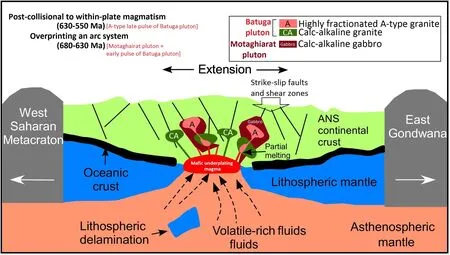
Fig.15 Geodynamic model representing post-collisional magmatism in the west Wadi Kalalat area.The mafic underplating magma produced two plutons;namely the calc-alkaline El Motghaiarat pluton and the calc-alkaline to highly fractionated A-type granite of the Batuga pluton.The figure is a modification for the geodynamic model of post collisional felsic magmatism presented by Sami et al.(2018) until 550 Ma.The suggested time span of mafic and felsic magmatism in the present modified model (680–550 Ma,from arc to post-collisional and within-plate settings) is based on data from Stern (2002),Johnson et al.(2011),Khudeir et al.(2021),Sami et al.(2018) for tectonism and associated magmatism in the northern segment of the Arabian–Nubian Shield
4 Conclusions
1.In the Wadi Kalalat area,felsic and mafic intrusions show no evidence of metamorphism and they represent the Gebel E Motaghairat and Gabal Batuga plutons,respectively.They were emplaced in country rocks made up of ophiolitic serpentinites and arc metagabbro-diorite.
2.The Gabal El Motaghairat mafic intrusion has a basal ultramafic member represented by fresh peridotite followed upwards by olivine gabbro and anorthositic or leucogabbro.
3.Although some outcrops show limited scale layering,the Gabal El Motaghairat intrusion cannot be assigned as a layered intrusion but as an Alaskan-type intrusion with typical tholeiitic nature.
4.Due to the intrusion of the Batuga felsic granites,some of the olivine gabbro belonging to El Motaghairat mafic intrusion is converted into hornfelsic melagabbro,which form a narrow thermal aureole at the contact.There are remarkable enrichment of SiO2,Al2O3,alkalis,Rb and Y in this melagabbro variety.
5.Geochemically,the Batuga felsic granites are high-K calc-alkaline in nature and represent fractionation products of the felsic melt in an arc setting bridging to a within-plate setting.Therefore,they are postcollisional granites with typical A2-subtype signature.
6.The two investigated intrusions are dissected by several diabase and aplite dykes characterizing an extensional regime defined by a proper within-plate setting.
7.Based on combined mineralogical and geochemical evidence,the fresh igneous intrusions in the Wadi Kalalat area give important clues that post-collisional mafic and felsic magmatism in the Arabian–Nubian Shield (ANS) is calc-alkaline,which formed in the transitional phase from arc to within-plate settings.
8.Finally,it is concluded that the younger granites are post-collisional A-types granites,which started to emplace during the waning stage of the arc system,and extended until a proper post-collisional extensional regime dominated.
Declarations
Conflict of interestThe authors declare that they have no known competing financial interests or personal relationships that could have appeared to influence the work reported in this paper.
杂志排行
Acta Geochimica的其它文章
- Geochemical modeling to aid experimental design for multiple isotope tracer studies of coupled dissolution and precipitation reaction kinetics
- The photosynthetic oxygen evolution does not exclude the important role and contribution of bicarbonate photolysis
- The co-transport of Cd(II) and nZnO in saturated soil packed column: effects of ionic strength and pH
- Facies development and sedimentology of the Middle Miocene carbonates of the Raghama Formation,northeastern Saudi Arabia
- Petrogenesis and tectonic implications of the Silurian adakitic granitoids in the eastern segment of the Qilian Orogenic Belt,Northwest China
- Distribution,health and ecological risk assessments of trace elements in Nigerian oil sands
